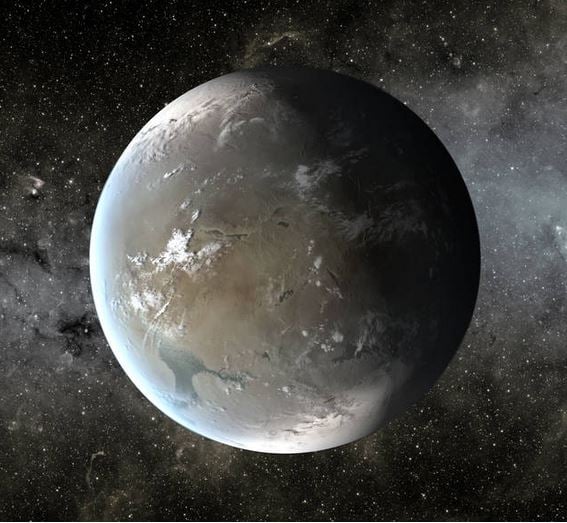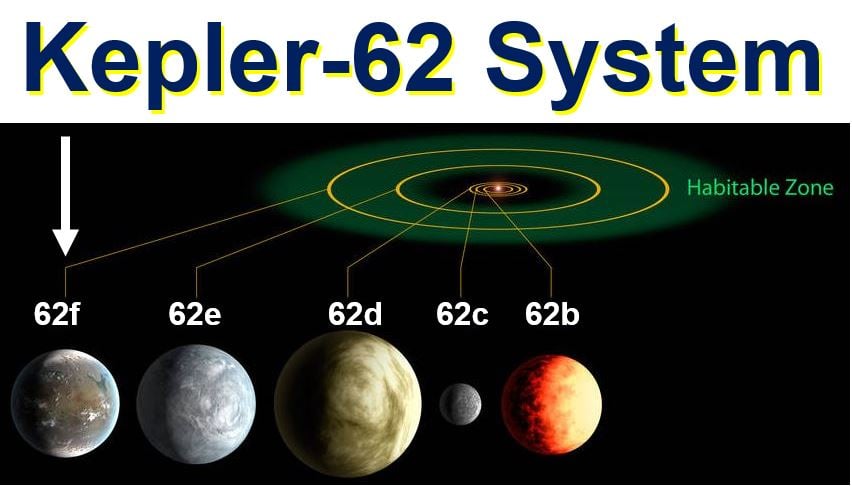A planet 1200 light years away might sustain life as we know it, or maybe have the right conditions for life to emerge, say scientists, who describe the exoplanet – called Kepler-62f – as a good prospect for a habitable world. An exoplanet is a planet outside our solar system.
For a planet to be ‘habitable’, there would need to be liquid water on its surface, so its temperature would have to be just right – neither too hot nor too cold.
Researchers from the University of Washington in Seattle, and the University of California in Los Angeles (UCLA), wrote about their study and findings in the scientific journal Astrobiology.
 The artist’s depiction of Kepler-62f, an exoplanet (super-Earth-size planet) in the habitable zone of a star smaller and cooler than the Sun, located about 1,200 light-years from Earth in the constellation Lyra. It completes one full orbit in 267 days and is 40% larger than Earth in size. (Image: nasa.gov)
The artist’s depiction of Kepler-62f, an exoplanet (super-Earth-size planet) in the habitable zone of a star smaller and cooler than the Sun, located about 1,200 light-years from Earth in the constellation Lyra. It completes one full orbit in 267 days and is 40% larger than Earth in size. (Image: nasa.gov)
Lead author Aomawa Shields, a National Science Foundation astronomy and astrophysics postdoctoral fellow at UCLA’s Department of Physics and Astronomy, and colleagues explained that they combined orbit and climate models on Kepler-62f, which is approximately 40% bigger than the Earth, and found that there is a good chance it has the right environment to sustain the kind of life that emerged on this planet.
This exoplanet is about 1,2000 light-years from here, in the direction of the constellation Lyra. Dr. Shields said it is within the range of exoplanets that are probably rocky and could well have oceans.
Scenarios set up to determine habitable features
NASA’s Kepler space observatory, which was launched in 2009 into an Earth-trailing heliocentric orbit, and was designed to survey a portion of our neighbourhood of the Milky Way to discover Earth-sized exoplanets in or near habitable zones, discovered the Kepler-62 solar system in 2013.
There are five exoplanets orbiting their parent star (Kepler-62), which is smaller and cooler than our Sun. Kepler-62f is the furthest away from the star. However, until this recent study, no data on this exoplanet’s composition, shape of its orbit or atmosphere had been produced.
 Kepler-62f is the furthest planet out in the inner solar system Kepler-62. Kepler-62 is a K2 dwarf – it is just two-thirds the size of our Sun and has one-fifth of its brightness. At seven billion years old, it is somewhat older than our Sun. (Image: nasa.gov)
Kepler-62f is the furthest planet out in the inner solar system Kepler-62. Kepler-62 is a K2 dwarf – it is just two-thirds the size of our Sun and has one-fifth of its brightness. At seven billion years old, it is somewhat older than our Sun. (Image: nasa.gov)
Dr, Shields, as well as Victoria Meadows, Rory Barnes, Cecilia Bitz, Eric Agol and Benjamin Charnay, all from Washington University, set out to find out whether Kepler-62f had the necessary ingredients to sustain life.
They set up some possible scenarios to determine what its atmosphere and orbital route might be like.
Regarding the possibility that this exoplanet might have liquid water on its surface, Dr. Shields said:
“We found there are multiple atmospheric compositions that allow it to be warm enough to have surface liquid water. This makes it a strong candidate for a habitable planet.”
Given that this exoplanet is considerably further away from its parent star than we are from our Sun, it would need to have significantly more carbon dioxide (CO2) than there is in Earth’s atmosphere. Just 0.04% of our atmosphere consists of CO2.
Greenhouse gases and the greenhouse effect
Carbon dioxide is a ‘greenhouse gas’, it contributes to a planet’s ‘greenhouse effect’. The greenhouse effect is a natural process in which certain greenhouse gases absorb the star’s sunlight and raise the average temperature of the atmosphere.
Faraway Earth-sized planet could be habitable, say @UCLA researchers https://t.co/gAZy5fslVc. #Kepler #space pic.twitter.com/FK4wauEFOx
— UCLA IoES (@UCLAIoES) 27 May 2016
In Earth’s case, the greenhouse gases – CO2, methane, nitrous oxide and ozone – warmed up the planet’s surface enough for liquid water to exist and life to emerge.
The scientists ran computer simulations on Kepler-62f having:
– several different CO2 atmospheric concentrations, ranging from what there is on Earth to 2,500 times its level.
– an atmosphere ranging from one Earth atmosphere to one twelve times thicker than Earth’s.
After assuming various concentrations of atmospheric CO2, they found a number of scenarios in which Kepler-62f could be habitable.
CO2 levels would need to be very high
The authors said that for this exoplanet to be habitable all year round, its atmosphere would need to be 3-to-5 times thicker than Earth’s, and composed virtually entirely of carbon dioxide.
Given its distance from its parent star, the high concentrations of CO2 would be necessary to have the right temperatures for liquid water to exist.
Regarding lower levels of CO2, Dr. Shields explained:
“But if it doesn’t have a mechanism to generate lots of carbon dioxide in its atmosphere to keep temperatures warm, and all it had was an Earth-like amount of carbon dioxide, certain orbital configurations could allow Kepler-62f’s surface temperatures to temporarily get above freezing during a portion of its year. And this might help melt ice sheets formed at other times in the planet’s orbit.”
The scientists used an existing computer model – HNBody – to make their calculations of Kepler-62f’s orbital route. To simulate the exoplanet’s climate, they used two existing climate models – the Laboratoire de Me´te´orologie Dynamique Generic model and the Community Climate System Model.
Never before had researchers combined the results from these two kinds of models to study a distant world, the authors claimed.
The authors believe the same technique could be used determine whether celestial bodies significantly closer to Earth could be habitable, as long as they were likely to be rocky.
Dr. Shields said:
“This will help us understand how likely certain planets are to be habitable over a wide range of factors, for which we don’t yet have data from telescopes.”
“And it will allow us to generate a prioritized list of targets to follow up on more closely with the next generation of telescopes that can look for the atmospheric fingerprints of life on another world.”
Authors have faith life is out there
So far, no compelling evidence has been found of life elsewhere in the Universe. However, the authors say they are optimistic that one day we will get lucky.
So far, we have confirmed the existence of more than 2,300 exoplanets. Several thousand more, waiting to be confirmed, are probably exoplanets too. However, only ten or twenty of them are known to be in the Habitable Zone or Goldilocks Zone – just the right distance from its parent star so that temperatures are warm enough (or cool enough) for there to be liquid water on its surface.
Earth is in the habitable zone of this Solar System. One wonders whether an intelligent civilisaton thousands of light years from here might be studying our planet, and publishing articles on Earth’s chances of sustaining life.
Citation: “The Effect of Orbital Configuration on the Possible Climates and Habitability of Kepler-62f,” Barnes Rory, Bitz Cecilia, Agol Eric, Charnay Benjamin, Shields Aomawa L., and Meadows Victoria S.. Astrobiology. May 2016. DOI: 10.1089/ast.2015.1353.
Video – Kepler-62f may have life
